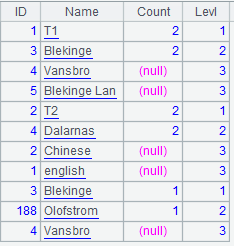Write Multilevel Data to One Data Set
【Question】
Is there a way to get one count of related items to the parent level and one count for the child level without breaking this into two queries?
I have two (relevant) MySQL tables. Courses_regions is used to relate courses to regions.
Regions{id, name, parent_id}
Courses_regions{id, region_id, course_id}
The data that I want to display on my frontend is a list of Region, sub-region and number of items (courses) related to the regions, as shown below:
Parent_region_name_a (5)
Child_region_name_a (2)
Child_region_name_b (3)
Parent_region_name_b (8)
Child_region_name_a (5)
Child_region_name_b (3)
The following query gives me the result I want, but without the count:
SELECT
t1.name AS lev1_name,
t1.id AS lev1_id,
t2.name AS lev2_name,
t2.id AS lev2_id
FROM regions AS t1
LEFT JOIN regions AS t2 ON t2.parent_id = t1.id
WHERE t2.name IS NOT NULL
ORDER BY t1.name
The result is:
lev1_name lev1_id lev2_name lev2_id
----------------------- ------- --------------- ---------
Blekinge län 3Olofström 188
Blekinge län 3Karlshamn 191
Blekinge län 3Sölvesborg 192
Dalarnas län 4Vansbro 319
Test län 5Gagnef 321
Test län 5Leksand 322
Test län 5Rättvik 323
This allows me to display the parent and sub regions with one query, but I can’t figure out how to add separate Count for level 1 and level 2.
Here are the tables:
Regions:
id name parent_id
3 Blekinge 1
4 Dalarnas 2
5 Test 6
188 Olofstrom 3
191 Karlshamn 3
192 Solvesborg 3
319 Vansbro 4
321 Gagnef 5
322 Leksand 5
323 Rattvik 5
1 T1
2 T2
Course:
id courseName
1 english
2 Chinese
3 Karlshamn
4 Vansbro
5 Blekinge Lan
Courses_regions:
id region_id course_id
1 3 4
2 5 3
3 3 5
4 4 2
5 188 4
6 4 1
【Answer】
To write data of different levels into one data set, SQL will get data of every level and then UNION the levels while set a specified order for outputting the levels of data. That makes lengthy and unintelligible code. Your question can be handled in SPL (Structured Process Language) with intuitive and easy to understand code:
| A |
|
| 1 |
$select ts.id id,ts.name name,ts.parent_ID parentID,tp.name as parentName, cr.course_ID courseID,c.courseName courseName from regions ts left join regions tp on tp.id=ts.parent_ID left join courses_regions cr on cr.region_ID=ts.id join course c on c.id=cr.course_id where ts.parent_ID is not null |
| 2 |
=A1.group(parentID) |
| 3 |
=A2.conj([~.parentID,parentName,~.count(),1]|~.group(id).conj([id,name,~.count(),2])|~.group@s(id).conj([courseID,courseName,null,3])) |
| 4 |
=create(ID,Name,Count,Levl).record(A3) |
A1: Associate the three tables with a JOIN.

A2: Group records by parentID.

A3: Concatenate sequences to generate records in the desired format.
A4: Create an empty table sequence and populate A3’s member to it.

esProc is designed to process structured data and an esProc SPL script can integrate with a reporting tool or a Java application through JDBC interface. That makes it an ideal tool to handle this type of computation. For more information, see How to Call an SPL Script in Java.
SPL Official Website 👉 https://www.scudata.com
SPL Feedback and Help 👉 https://www.reddit.com/r/esProcSPL
SPL Learning Material 👉 https://c.scudata.com
SPL Source Code and Package 👉 https://github.com/SPLWare/esProc
Discord 👉 https://discord.gg/2bkGwqTj
Youtube 👉 https://www.youtube.com/@esProc_SPL


